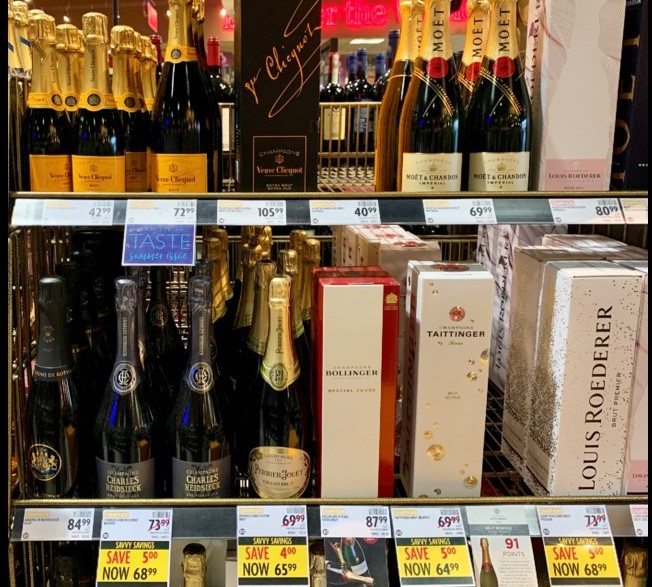What’s the sparkling wine of your choice?
How are you planning to celebrate the beginning of 2023? Chances are you’ll be reaching for a bottle of sparkling wine. Although inflation is a reality with most of us, the temptation to indulge in a bottle of Champagne is hard to resist. Prices start around $70 and can climb to thousands of dollars!
Champagne
Champagne is a sparkling wine but not all sparkling wines are Champagne! Only wine from the Champagne region of France can bear the prestigious label. It must undergo a secondary fermentation in the bottle you purchase and be produced from one or more of pinot noir, chardonnay and pinot meunier. It’s a time-consuming process and the resulting nectar of the gods is in high demand. Hence the expensive price!
Faced with dozens of bottles of Champagne on liquor store shelves you might be tempted to close your eyes and reach for a random bottle. But there’s a better way!
First, do what 90 per cent of Champagne buyers do: choose Brut Champagne. It’s dry and produced from blends of different vintages.
There are about 100 Champagne houses and each one has its own style. To keep it simple, there are four basic characteristics: floral or fruity aroma and flavour; yeasty, bread or toast aroma and flavour; light-body; or heavier-body.
Floral or fruity aroma and flavour are produced when the wine doesn’t spend much time on the lees (dead yeast cells at the bottom of the bottle). These wines will have a floral bouquet and fruity flavour such as apple or pear, or currant and a light body. Taittinger and Moet et Chandon are two such Champagnes.
Other houses focus on creating yeasty, toasty, or bread-like characteristics. The longer the house ages its wines on the lees, the more the wine has this “biscuit” profile and a heavier body.
Meanwhile, light-bodied Champagne has mainly white chardonnay while heavier-bodied ones have more red pinot noir or pinot meunier.
Some Champagnes have only one of these characteristics. Bollinger reveals a yeasty style while Pol Roger is more floral and fruit-driven. Many types of Champagne are hybrids and have both toasted and fruity characteristics.
- Charles Heidsieck is floral and fruity with toast and a medium body. Plums, cherries, mango, apricot and dried fruits plus pastry, baked brioche, pistachio and almond.
- Louis Roederer Collection 242 is rich and toasty, complex, and nutty, medium-body, with notes of pear, peach, citrus and white flowers.
- Bollinger Special Cuvée Brut is another hybrid! It’s 60 per cent pinot noir, full-bodied, fermented in oak barrels, complex and rich, creamy, yeasty, and concentrated, with notes of citrus cherries, apples, flowers, toast, walnuts and apricots.
- Veuve Clicquot is medium to full body with 50 per cent pinot noir. It’s rich and complex with Honeycrisp apple, peach, plum, pear, cherry and lemon plus toasty brioche and vanilla.
- Piper Heidsieck is medium-bodied with 50 per cent pinot noir, with rye bread toast, hazelnuts, lemon tart, and ripe black cherry with spice.

Sparkling wines
What about sparkling wines that are not Champagne? In France, there are eight appellations, which are Crémant. Sparkling wines called Crémant were named because their lower carbon dioxide pressures were thought to give them a creamy rather than a fizzy mouth-feel.
The Loire Valley is France’s largest producer of sparkling wines outside of Champagne. Crémant de Loire is a blend of chardonnay, chenin blanc and cabernet franc. Crémant de Bourgogne must have at least 30 per cent pinot noir, chardonnay, pinot blanc or pinot gris.
Cava is Spain’s answer to Champagne but it’s much cheaper. Most of it is produced in Catalonia near Barcelona. Cava must be made according to the méthode traditionnelle with second fermentation in the bottle and use a variety of macabeau, parellada xarel-lo, chardonnay, pinot noir and subirat grapes. Segura Viudas, Freixnet, Codorniu and Jaume Sera are some of the popular Cavas.
Sparkling wines are produced throughout Italy but Prosecco from Veneto is the most popular. Most Italian sparkling wines, especially Asti and Prosecco, are made with the cheaper Charmat method.
Prosecco is made from the glera grape. It’s almost always made in the sparkling style (Spumante) with longer-lasting bubbles or semi-sparkling style (frizzante) with fewer lingering bubbles. Most Proseccos are extra dry (which is sweeter than the driest Brut style) and white, but a rosé version was recently introduced which includes pinot noir.
Here in B.C., most wineries produce excellent sparkling wines. Harry McWatters was a pioneer in making the first B.C. sparkling wine at Sumac Ridge, Stellars Jay Brut, named after the provincial bird. Summerhill Pyramid Winery has a wide selection of organic and biodynamic sparkling wines including their first, the Cipes Brut, which is made of riesling, pinot blanc and chardonnay. The Okanagan Crush Pad (Haywire) has also been making organic wines with a wide selection of sparkling wines.
Hester Creek, Township 7, Time, Evolve, Unsworth, Blue Grouse, Fitzpatrick and Jackson Triggs are just a few of the BC sparkling wines available to celebrate the New Year and to enjoy throughout the year.
Serve in regular white wine glasses with a large bowl so you can experience the aromas. If you use flutes, you will see the beads of bubbles travelling up further in the glass, but they don’t capture the aroma well. If you use old-fashioned saucer glasses, the bubbles will be lost rapidly and the glass doesn’t concentrate the aromas. Your choice! Happy 2023!
Source/ Richmond News/ Column: Eric Hansonabout



